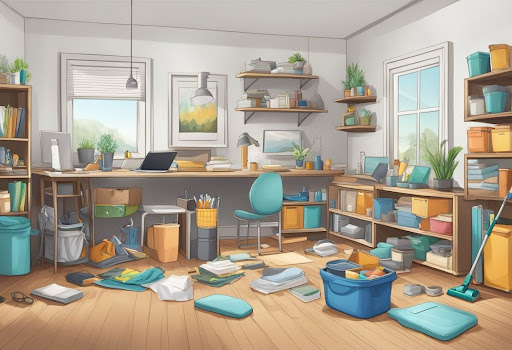Over 262 million people in the world unfortunately have asthma. Breathing difficulties can affect your quality of life more than you might guess, and clean air is something you require to live healthily.
Asthma is often triggered and caused by poor ventilation and air quality – so what can you do to lessen asthma symptoms, breathe deep, and decongest?
Read on as we explore the signs that your home’s air quality isn’t up to scratch and how decluttering can help you improve home ventilation.
What Are The Signs Your Home Has ‘Dirty’ Air?
Ventilation is vitally important if you want to get plenty of nourishing oxygen when you breathe and avoid dust, chemicals, and other nasties sneakily getting into your lungs.
Most people carelessly don’t think about the air quality at home. They clean, tidy, and decorate but neglect to give their lungs the breathable and clean air they need.
Without being proactively invested and purchasing an air quality monitor, here are the best ways to tell if your home has clean or dirty air:
- You have allergic symptoms: Whether it’s asthma, hives, or irritated eyes, you may have annoyingly increased allergic symptoms due to the increased presence of dust and nasties in the air at home.
- You have mould: Mold isn’t just restricted to one spot. It makes its way into the air via tiny spores and then maliciously enters your lungs, making you sick. If you have mould in the first place, it’s usually a forewarning sign that your home is too humid and damp, signifying the imminent need for better ventilation.
- You’re getting sick more often: If you’re breathing in dirty and contaminated air all day long at home, it will inevitably mess up your immune system. This means that you’re more likely to get sick, picking up common colds and illnesses more easily.
- You’re experiencing fatigue: Tiredness can come hand-in-hand with poor air quality, as you could be breathing in harmful chemicals that restrict airflow in your lungs. You won’t get as much oxygen and not enough to feel healthily alert and at your best.
- You’re coughing and wheezing: Since air quality ultimately affects the lungs, you’ll obviously notice you’re coughing and wheezing more if you have dirty air. You can expect more mucus than normal, too.
If you have any of these symptoms, wisely invest in an air quality test for your home or begin improving the air quality with simple and manageable steps.
Top Causes Of Poor Air Quality At Home
So, now you’re frantically wondering how you can improve the air quality in your home. Well, it’s all relaxingly simple once you find the root cause. So, let’s discuss some of the most common causes of poor air quality at home so you assuredly know where to start looking.
Gas Leaks
Gas leaks can come from anywhere in your home. Whether you’re boiler or stove is leaking gas, or there are hidden gas pipes and transport systems through your home, you’ll need a proper carbon monoxide detector to ensure your home is safe. Gas leaks can cause explosions, severe poisoning, and even death.
Pets
Your pets could (cute as they are) be the cause of poor air quality in your home. Their zoomies bring pollen and dust into your home from the outdoors and release something called dander, a common allergen. So, if you’re experiencing allergic symptoms, it’s best to restrict your pet to just one area in the house.
Chemicals
Chemicals like asbestos could be in your home, and you could breathe in copiously dangerous amounts. It’s affecting air quality without your knowledge – which is why you should always have a cautionary asbestos survey performed before moving anywhere.
Poor Cleaning Habits
Poor cleaning habits lead to dust buildup in cracks and crevices. When there’s movement in the room, some of the dust will disperse and kick up into the air, and you’ll unknowingly breathe it in. This is why hygiene at home is so important.
What’s The Best Way To Improve Indoor Air Quality At Home?
The simple answer? Cleaning. And, reducing the amount of clutter lying around. Clutter is what’s known as a ‘dust catcher’. It’s just another surface in your home for dust to sit on and another surface to clean. The minimalist home look is very on-trend, and keeping your knick-knacks tucked away in a cupboard will spare them sun and dust damage.
When cleaning your home, these are the best practices to follow to get rid of the dust (rather than simply move it around):
- Clean top-to-bottom: If you dust after you’ve hoovered and mopped, all of the dust you dislodge will go directly onto your clean floors. So, dust first, then polish, then clean the floor!
- Keep your surfaces clear: To declutter one room at a time, look at all the countertops and shelves in that space and remove all but 2 or 3 items to make it easier to keep clean.
- Use a steamer: A steamer completely sterilises fabrics and furniture, helping to eliminate dust trapped in your couch and bed frame.
- Don’t forget skirting boards: Your skirting boards are low in the room and can harbour quite a disgraceful amount of dust if you neglect to clean them regularly.
Summary
Well, now that you know how exceedingly harmful and toxic household dust and air pollutants can be for your health. So, what are you going to do about it? It’s essential to have a carbon monoxide detector at home for your safety, but you should also consider sticking to a regular cleaning and dust-catching schedule to breathe immensely better when in the comfort of your home.

